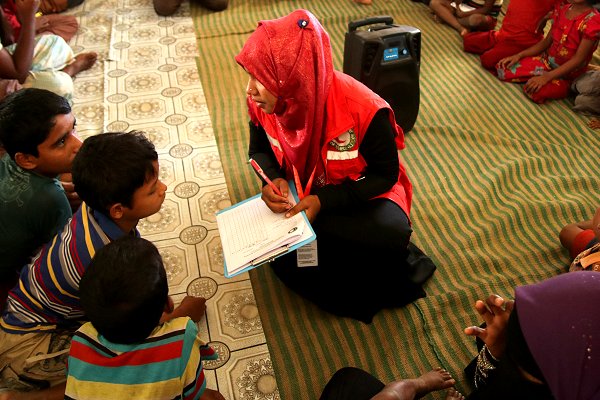
IFRC: Hundreds of thousands ‘worryingly exposed’ in Cox’s Bazar camps ahead of cyclone and monsoon seasons

(This story appeared first on the IFRC website yesterday. It has been edited here for time references.)
An estimated 574,000 people in camps close to Bangladesh’s Cox’s Bazar face the coming cyclone seasons with only rotting bamboo and shredding plastic to protect them, the IFRC warned yesterday.
A Red Cross Red Crescent survey found that 82 per cent of the 700,000 people in sprawling camps urgently need sturdier shelters to protect them from extreme temperatures, monsoon downpours and two cyclone seasons a year.
It is almost exactly 18 months since violence erupted in Rakhine state in Myanmar, forcing people to flee.
Azmat Ulla, head of the IFRC country office in Bangladesh, said: “Housing conditions in these camps are basic. However, after 18 months they have dramatically deteriorated, leaving people worryingly exposed.
“The aid community in Cox’s Bazar needs to prioritize repairing and replacing these battered shelters, so that people have some protection against the elements, and are provided with at least some basic comfort and dignity.”
In recent weeks, Red Crescent staff and volunteers have distributed tarpaulins, ropes and tools to 49,000 families, benefiting 200,000 people.
The Bangladesh Red Crescent Society (BDRCS), supported by IFRC and other Red Cross and Red Crescent partners, has so far trained 8,400 people to make their shelters safer, and more training is coming.
BDRCS Secretary General Feroz Salah Uddin said: “In the coming months, people need sturdier structures that can resist cyclones and other forms of disasters.
“Our trained technicians are helping camp residents improve their own shelters. This is especially important for people with disabilities and the elderly, as well as female- and child-headed households.”
‘These people have nowhere to evacuate to’
Ahead of the cyclone season in April and May, the BDRCS and government agencies are also training thousands of volunteers from the Rakhine community in cyclone preparedness.
But the IFRC’s Ulla said: “All the cyclone preparedness training, well-rehearsed emergency drills and necessary equipment in the world will not protect people if a deadly tropical cyclone barrels up the Bay of Bengal, as has happened in the past. The fact remains that these people have nowhere to evacuate to.
“The pitiful state of people’s shelters illustrates how utterly unsustainable and unsafe this life is.
“We continue to call for an urgent political solution to this crisis. But in the meantime, more is needed to at least provide people with basic comfort and dignity.”
In the past 18 months the BDRCS, supported by IFRC and Red Cross and Red Crescent partners from around the world, has reached over 250,000 people with emergency help including food, water and shelter equipment. More than 160,000 have received medical care.
BDRCS community volunteers talk to children in December to test their understanding of information about cholera prevention broadcast on local radio. (Photo: Sajid Hasan/IFRC)